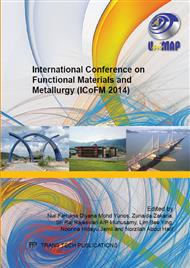p.314
p.319
p.325
p.331
p.337
p.341
p.347
p.353
p.361
Biomedical Applications: Composite Metal Alloys with Additives
Abstract:
Recently, many researchers focused on biocompability, corrosion resistance and properties behavior of implant materials in order to length the endoprostheses life. One of the rapid development areas of research is in the biomaterials field. Historically the uses of biomaterials has been to replace diseased or damaged tissues. This present paper reviews the research works carried out in the field of composite metal alloys reinforced with additive and to analyze the influence of modifying additive on mechanical properties of composite materials on the cobalt (Co), titanium (Ti) and magnesium (Mg) based alloy. The desirable mechanical properties of the matrix component compensate for the poor mechanical behavior of the biomaterials, while in turn the desirable bioactive properties of the additives improve those of metal alloys. The following additives were reviewed for research: poly methyl methacrylate (PMMA), fluoroapatite (FA) and bioglass. Results show that these composites can be the alternative materials for biomedical applications.
Info:
Periodical:
Pages:
337-340
Citation:
Online since:
June 2015
Price:
Сopyright:
© 2015 Trans Tech Publications Ltd. All Rights Reserved
Share:
Citation:


